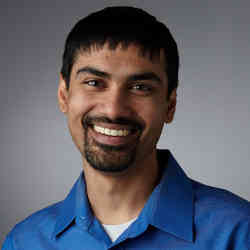
Shwetak Patel loves to combine academic research with being an entrepreneur, all in the field of sensing technology and ubiquitous computing. At a press conference during the 9th Heidelberg Laureate Forum this September, he put it this way: "Being an academic is my intellectual playground. Entrepreneurship is a way to show impact. When I was a young researcher, one of my goals was to build something that could impact the lives of a million people. I hit that goal, so now I'm going to go for a billion people."
Patel is the Washington Research Foundation Entrepreneurship Endowed Professor in Computer Science & Engineering, and Electrical and Computer Engineering, at the University of Washington. In 2018, he was awarded the ACM Prize in Computing for his contributions to creative and practical sensing systems for sustainability and health. As a result, he was invited to the Heidelberg Laureate Forum (HLF), an annual conference where 200 young researchers spend a week interacting with laureates of the most important prizes in computer science and mathematics.
Among many other applications, Patel and his research group have developed a new way of screening for tuberculosis using low-cost microphones to monitor coughing, and a way of using a smart watch to predict whether somebody is infected with the COVID-19 virus days before symptoms appear (based on a combined measurement of heart rate, heart rate variability, and respiratory rate). Says Patel, "With more intelligent sensors integrated into the Internet of Things, we can better understand the world, better intervene, and better take action. Sensors make the unknown known, and when we combine sensing with AI (artificial intelligence), as is happening now, you get so many new possibilities."
Presently his group is working on smartphone-based diabetes screening using newly developed enzymatic strips that can be read by the touchscreen of an ordinary smartphone. "There are seven billon smartphones in the world, so potentially you could screen seven billion people," said Patel during his HLF lecture.
Patel talks quickly and energetically. During the week in Heidelberg, he attracted many young researchers to talk with him for inspiration and ideas. "I asked him about several challenges I am facing in my own research," said Taiwanese researcher Yen-Chia Hsu from the University of Amsterdam. "Hearing his answers, I got the feeling that it's not just me having these challenges; these laureates are also have them. I asked Patel how he solves them, and from his ideas I got inspiration about how I can do it myself."
Patel tries to bring his innovative ideas to the market, which was very uncommon when he started working at the university. "At that time, some 15 years ago, I was criticized at the university for also being an entrepreneur," he said. "The prevailing idea was that you are either a professor or you are an entrepreneur. My response was: 'Why do I have to pick?' I am very problem-driven and in the end I want to have impact, and many students also want to have impact. Our work is federally funded, so it is in society's best interest that people can actually directly benefit from our research."
Times have changed, and today Patel doesn't hear that criticism. "Students are more entrepreneurial now. Half the time when students come to my office, it is not to talk about the class or the assignments, but about how to be an entrepreneur. That is so exciting."
Patel said his work has always been motivated by his desire to contribute to global health. He wants the solutions his group invents to work well in less-developed nations, as well as in the First World, so he tells his students not to assume everyone has a smartphone that is under a year old; "assume they have a smartphone that is five to 10 years old. A lot of our field trials we do outside the U.S., for example in South Africa, India, and Bangladesh. When we use a phone camera, we realize very well that our sensor technology must work for all skin tones, not just light ones."
Asked about the most important current grand challenges in his field, Patel named several. "One of the grand challenges is how to power all these sensors. Batteries are often unpractical. For sensors on the body, we experiment with patches that use the movement of the body as a power source. We also try to use the power of the breath.
"Another grand challenge is the deployment of all those sensors in an environment. How should they communicate? If you want to use sensors on a large scale in health care, there is the problem of data management. How to do that in such a way that it doesn't disrupt the daily flow of physicians and clinics?
"And finally, a grand challenge is to make sensors sustainable. Present-day sensors are built of hard-to-recycle stuff. We are experimenting with an easy-to-recycle sort of plastic, called vitrimir. However, that in turn leads to new problems, because it leads, for example, to more electronic noise."
The surface of sensoring technology and ubiquitous computing has barely been scratched, according to Patel. "We have built a lot of fundamentals. But we are just starting to figure out what we can do with that. There is a ton of scientific work to do."
Bennie Mols is a science and technology writer based in Amsterdam, the Netherlands.



Join the Discussion (0)
Become a Member or Sign In to Post a Comment